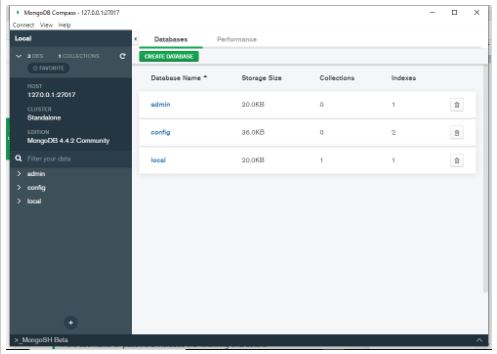

Create databases and Insert, update, and delete data in your database. Compass can carry out all the operations that Mongo Shell does and more, including: Visualize and explore data stored in your database. Let us first create a collection with documents − > db.countandsumdemo. MongoDB Compass is a much better alternative for the Mongo shell. db.inventory.find().Use aggregation $gte and $lte along with $sum to count and sum a field between 2 dates. In this example, we retrieve the document with the exact _id value “LS0009100”.

For example, run the commands use myDatabase and db.m圜ollection.find(). Matches none of the values specified in an array. Tip: You can use MongoDB Compass to easily view collections in your database.
MONGODB COMPASS COUNT FREE
Matches values that are not equal to the given value. eddy bower Total count: 2 35 m WHAT IS COMPASS MongoDB Compass is a free GUI tool for MongoDB that enables you to manage data in a MongoDB database. MongoDB Compass is free and supported by the MongoDB team, but there are many alternatives depending on your requirements. Matches if values are less or equal to the given value. Most admin tools use the MongoDB API for broader cross-version compatibility. Matches if values are greater or equal to the given value. Matches if values are less than the given value. mongodb compass binary, mongodb compass community, mongodb compass count. Matches if values are greater than the given value. MongoDB compass connect to localhost and use of Projection, LIMIT and SKIP. Matches values that are equal to the given value. The following table contains the common comparison operators. MongoDB comparison operators can be used to compare values in a document. Collections: employees, inventory, payments, promo.(We won’t touch on them all, there are so many.) We’ll use the following dataset with the find() function to demonstrate each operator’s functionality. Now, let’s look at commonly used operators. The dataset that we will be using is a CSV file containing. In other words, MongoDB lets you select fields and group together documents based on your selection in order to find duplicate documents. Use a SQL LIKE statement in MongoDB with the find command and search for word. MongoDB operators can be used with any supported MongoDB command. MongoDB's aggregation pipeline makes finding duplicate documents easier by allowing you to customize how documents are grouped together and filtered. MongoDB allows users to analyze the content of their stored data without any prior. You can also create your own metrics using custom find, count and. MongoDB offers the following query operator types: Since v.3.4 (i think) MongoDB has now a new aggregation pipeline operator named 'facet' which in their own words: Processes multiple aggregation pipelines within a single stage on the same set of input documents. mongodb (from source) is going to remove. The query operators enhance the functionality of MongoDB by allowing developers to create complex queries to interact with data sets that match their applications. Operators are special symbols or keywords that inform a compiler or an interpreter to carry out mathematical or logical operations. MongoDB offers different types of operators that can be used to interact with the database. Returns a document that contains this count and as well as the command status.

MONGODB COMPASS COUNT HOW TO
Use the right-hand menu to navigate.) What are MongoDB operators? I am playing around with MongoDB trying to figure out how to do a simple SELECT province, COUNT() FROM contest GROUP BY province But I can't seem to figure it out using the aggregate function. Counts the number of documents in a collection or a view. (This article is part of our MongoDB Guide. We’ll explain what they do, then share examples so you can see how they work. In this article, we will take a look at the most commonly used query operators.


 0 kommentar(er)
0 kommentar(er)
